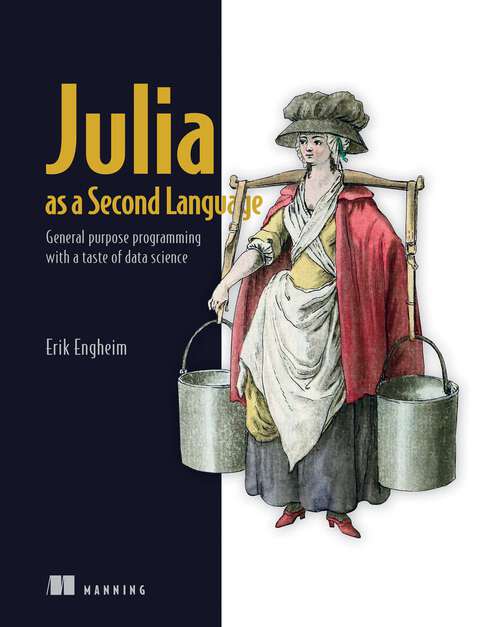Julia as a Second Language
By:
Sign Up Now!
Already a Member? Log In
You must be logged into Bookshare to access this title.
Learn about membership options,
or view our freely available titles.
- Synopsis
- Learn the awesome Julia programming language by building fun projects like a rocket launcher, a password keeper, and a battle simulator.Julia as a Second Language covers: Data types like numbers, strings, arrays, and dictionaries Immediate feedback with Julia&’s read-evaluate-print-loop (REPL) Simplify code interactions with multiple dispatch Sharing code using modules and packages Object-oriented and functional programming styles Julia as a Second Language introduces Julia to readers with a beginning-level knowledge of another language like Python or JavaScript. You&’ll learn by coding engaging hands-on projects that encourage you to apply what you&’re learning immediately. Don&’t be put off by Julia&’s reputation as a scientific programming language—there&’s no data science or numerical computing knowledge required. You can get started with what you learned in high school math classes. About the Technology Originally designed for high-performance data science, Julia has become an awesome general purpose programming language. It offers developer-friendly features like garbage collection, dynamic typing, and a flexible approach to concurrency and distributed computing. It is the perfect mix of simplicity, flexibility and performance. About the Book Julia as a Second Language introduces Julia by building on your existing programming knowledge. You&’ll see Julia in action as you create a series of interesting projects that guide you from Julia&’s basic syntax through its advanced features. Master types and data structures as you model a rocket launch. Use dictionaries to interpret Roman numerals. Use Julia&’s unique multiple dispatch feature to send knights and archers into a simulated battle. Along the way, you&’ll even compare the object-oriented and functional programming styles–Julia supports both! What&’s Inside Data types like numbers, strings, arrays, and dictionaries Immediate feedback with Julia&’s read-evaluate-print-loop (REPL) Simplify code interactions with multiple dispatch Share code using modules and packages About the Reader For readers comfortable with another programming language like Python, JavaScript, or C#. About the Author Erik Engheim is a writer, conference speaker, video course author, and software developer. Table of Contents PART 1 - BASICS 1 Why Julia? 2 Julia as a calculator 3 Control flow 4 Julia as a spreadsheet 5 Working with text 6 Storing data in dictionaries PART 2 - TYPES 7 Understanding types 8 Building a rocket 9 Conversion and promotion 10 Representing unknown values PART 3 - COLLECTIONS 11 Working with strings 12 Understanding Julia collections 13 Working with sets 14 Working with vectors and matrices PART 4 - SOFTWARE ENGINEERING 15 Functional programming in Julia 16 Organizing and modularizing your code PART 5 - GOING IN DEPTH 17 Input and output 18 Defining parametric types
- Copyright:
- 2023
Book Details
- Book Quality:
- Publisher Quality
- Book Size:
- 400 Pages
- ISBN-13:
- 9781638351900
- Related ISBNs:
- 9781617299711
- Publisher:
- Manning
- Date of Addition:
- 05/02/23
- Copyrighted By:
- Manning Publications Co.
- Adult content:
- No
- Language:
- English
- Has Image Descriptions:
- No
- Categories:
- Nonfiction, Computers and Internet
- Submitted By:
- Bookshare Staff
- Usage Restrictions:
- This is a copyrighted book.
